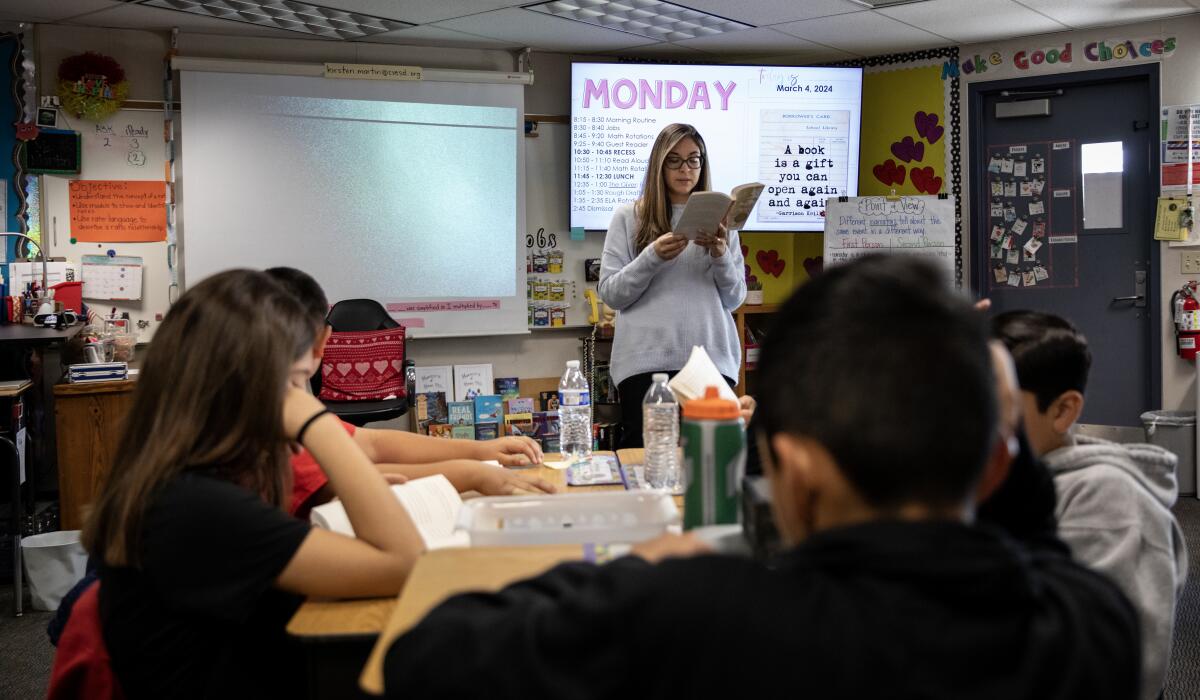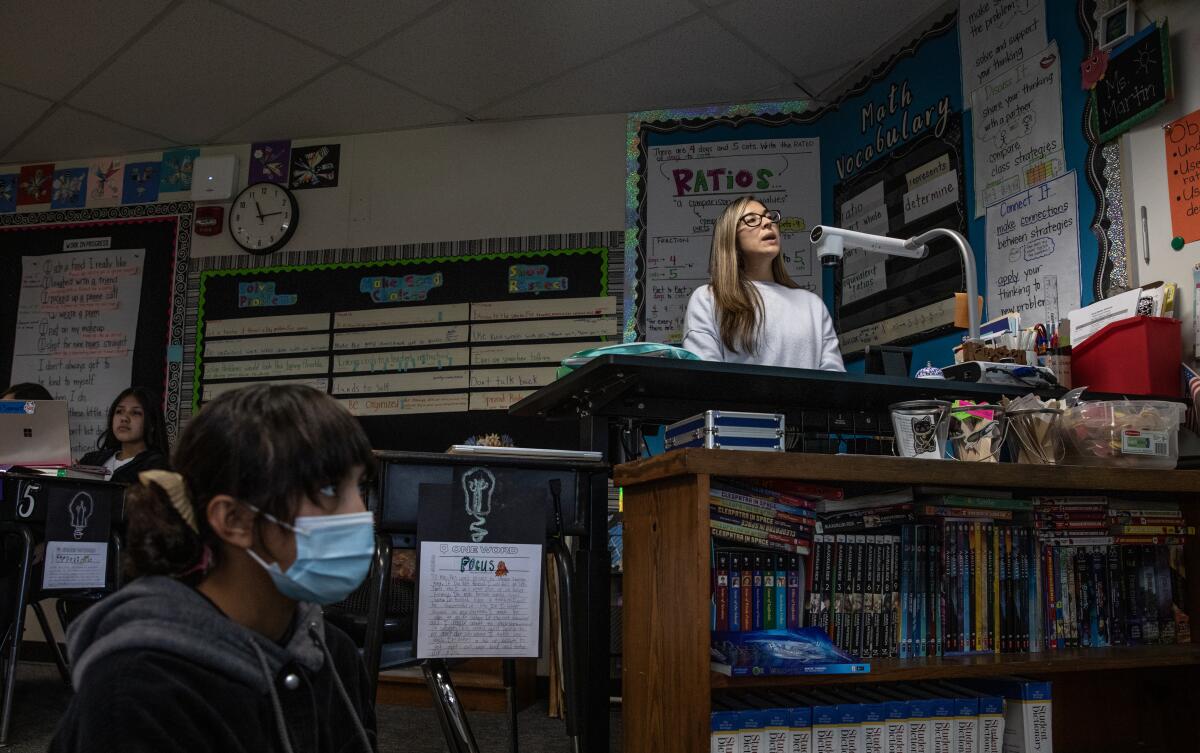It was the pandemic that made Carolina Abrego decide to become a teacher.
When schools shut down, Abrego, then a stay-at-home mom, suddenly became her kindergarten boys’ home school teacher. But she enjoyed teaching them to read and write.
So she started getting more involved at their school, Corky McMillin Elementary in Chula Vista, volunteering with teachers and getting hired as a noon-duty assistant.
Then the district advertised a new opportunity — she could become a certified teacher in the district in 18 months, and they would pay her $40,000 to do it. She signed up.
“I’m getting paid to do what I like and to study,” Abrego said.
Abrego is part of the first cohort of Chula Vista Elementary School District’s new teacher residency, a program meant to create quality K-12 teachers within a year and a half. By the end of it, residents get a teaching credential, a master’s degree and at least one school year’s worth of classroom teaching experience alongside a mentor teacher.
California has invested more than $600 million since 2018 into teacher residency programs such as Chula Vista’s.
The hope is that they will help solve teacher shortages in hard-to-staff areas and create quality and diverse teachers for schools, especially schools in low-income communities, which often get fewer teaching applicants. Local residencies are offering pathways in areas like special education and bilingual education that are especially difficult to staff.
“The state has made a major investment in this (teacher) pathway, and that’s seen as the gold standard pathway by many,” said researcher Andrew Brannegan of WestEd, a San Francisco-based research agency that has been studying California’s teacher residencies for the state’s credentialing commission.
But the state’s big investment has had mixed success — particularly in recruitment, because so few would-be teachers can afford such programs, WestEd researchers have found. Researchers also worry the programs won’t last in the long run after the state’s grant funding runs out.

Carolina Abrego reads “The Giver” to sixth graders at Rohr Elementary School on Monday, March 4, 2024, in Chula Vista. Abrego is part of a teacher residency program and has been with the students since the beginning of the school year. The program takes 18 months to complete.
(Ana Ramirez/The San Diego Union-Tribune)
Chula Vista Elementary started its residency program last year with National University, because it has struggled to recruit enough teachers in recent years for special education and bilingual education, said Jorge Mora, the district’s executive director of human resources. It is now recruiting up to 20 teachers for its second cohort, which will start this summer.
San Diego Unified is also starting a teacher residency program this year with spots for 30 people, working with the University of San Diego, UC San Diego and San Diego State.
Here’s how it works: Residents take teaching courses through the university while teaching four days a week in a school alongside a district mentor teacher. For Chula Vista and San Diego Unified, the residency takes a year and a half.
Getting hired by the district after completion isn’t a guarantee but is based on performance in that program. For Chula Vista’s program, residents who complete it successfully are awarded a four-year teaching contract.
The residents pay tuition but get paid a stipend. Chula Vista pays $40,000, while San Diego Unified will pay between $37,500 and $50,000.
The residency is designed to develop higher-quality teachers by giving residents the experience of working a full school year and pairing them with an experienced teacher mentor. Student teaching experience in a typical university program might involve only six to nine weeks of teaching in a classroom, Mora said.
School districts also hire paid interns, but they are less desirable to the district than teacher residents, Mora said. Some research has found that teachers who complete residencies are more likely to keep working in the classroom for at least three years after the program, compared with teachers who first work as interns or on an emergency teaching permit.
“We feel there would be a much greater chance of success when someone has had the mentorship,” Mora said.

Allison Villa, 11, listens as Carolina Abrego teaches math to sixth graders at Rohr Elementary School.
(Ana Ramirez/The San Diego Union-Tribune)
But WestEd researchers have found mixed success among teacher residencies.
Residencies across the state have struggled to fill their rosters, unable to find enough applicants who meet program admission requirements. California teacher residencies are also unaffordable for many prospective teachers.
The state’s grants now provide up to $40,000 per resident — in 2021 it was only $25,000. There used to be no minimum stipend required for residents; as of this year, the state requires at least $20,000, which is still not enough both to cover the residents’ tuition costs and to pay them a living wage.
Teacher residents can apply for a $20,000 Golden State Teacher Grant, which is open to students in teacher preparation programs working toward a credential who have pledged to work at a state priority school for four years. There are also federal TEACH grants, which provide up to $4,000, and federal Pell Grants.
Local programs also offer other ways to reduce the financial burden on residents.
Residents can increase their pay if they substitute for the fifth day of the week when they are not teaching in the classroom alongside their mentor. The University of San Diego is also offering $10,000 need-based scholarships for residents, and National University gives teacher residents a 25 percent tuition discount.
Abrego said she is financially able to do the residency only because her husband supports the family financially. In addition to her $40,000 stipend, she was awarded a Golden State Teacher Grant and said she is waiting for those funds to land.
The residency program is challenging, Abrego added. On top of teaching several days a week, she must also complete two to three courses a month, study for state credentialing tests and volunteer 12 hours a month.
That’s on top of taking care of her two children, now 8.
“It is stressful,” Abrego said. “It’s a lot, but if you have the passion and the dedication ... at the end of the road, it’s rewarding.”
The Link LonkMarch 10, 2024 at 07:00PM
https://news.google.com/rss/articles/CBMilwFodHRwczovL3d3dy5zYW5kaWVnb3VuaW9udHJpYnVuZS5jb20vbmV3cy9lZHVjYXRpb24vc3RvcnkvMjAyNC0wMy0xMC9zYW4tZGllZ28tc2Nob29sLWRpc3RyaWN0cy10cnktcmVzaWRlbmN5LXByb2dyYW1zLXRvLWRldmVsb3AtbW9yZS1xdWFsaXR5LXRlYWNoZXJz0gEA?oc=5
San Diego County schools badly need these hard-to-staff teachers. Can residency programs help? - The San Diego Union-Tribune
https://news.google.com/search?q=hard&hl=en-US&gl=US&ceid=US:en
No comments:
Post a Comment